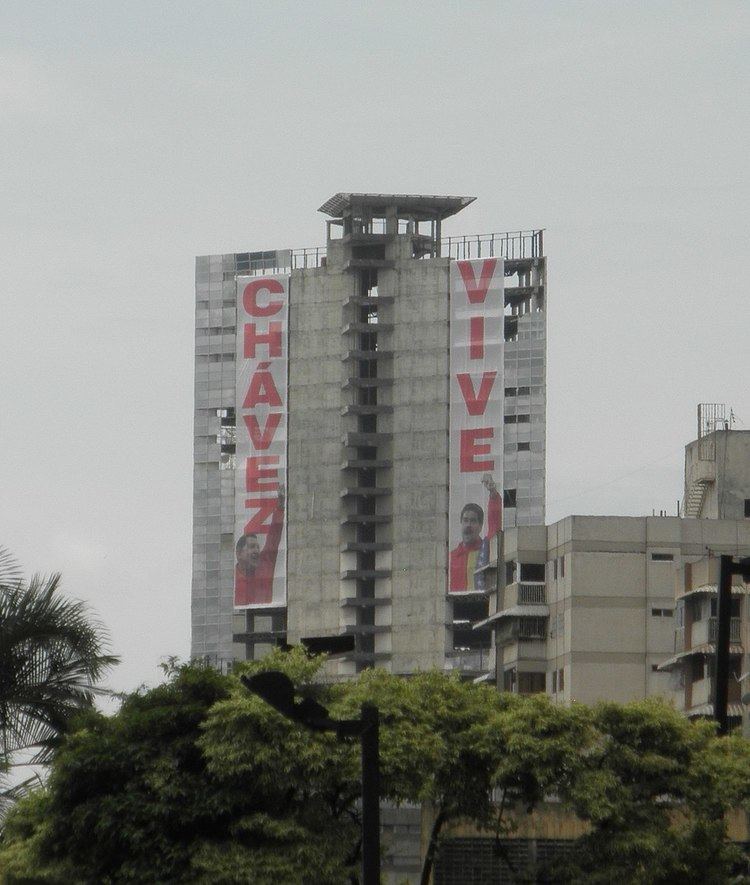Roof 190 m (620 ft) Height 190 m Status Unfinished building Estimated completion 1994 | Owner Corpolago C. A. Floor count 45 Floors 45 Construction started 1990 | |
 | ||
Type OfficeHotelAparthotel Floor area 121.741 m² (1310.41 sq ft) Similar | ||
Centro Financiero Confinanzas, also known as Torre de David (the Tower of David), is an unfinished skyscraper in Caracas, the capital of Venezuela. It is the third highest skyscraper in the country after the twin towers of Parque Central Complex. The construction of the tower began in 1990 but was halted in 1994 due to the Venezuelan banking crisis. As of 2016, the building remains incomplete and unused.
Contents
- Venezuela s tower of dreams documentary
- Construction and banking crisis
- Residence by squatters
- Relocation
- Possible future
- In popular culture
- References
Venezuela s tower of dreams documentary
Construction and banking crisis
This tower in downtown Caracas is nicknamed "Torre de David" after David Brillembourg, the tower's main investor who died from cancer in 1993. During the banking crisis of 1994, the government took control of the building and it has not been completed since. The building lacks elevators, installed electricity, running water, balcony railing, windows and even walls in many places. The complex has six buildings: El Atrio (Lobby and conference room), Torre A that is 190m tall and stands at 45-stories still includes a heliport, Torre B, Edificio K, Edificio Z, and 12 floors of parking.
In 2001, the Venezuelan government made the attempt to auction off the complex, though no one made an offer.
Residence by squatters
In the 2000s and 2010s, Caracas suffered from a housing shortage, with shortages amounting to about 400,000 Caracas homes in 2011. Construction of homes halted in Venezuela due to the fears of expropriations that occurred under the Bolivarian government while the government was also unable to build enough homes for Venezuelans. Citizens of Caracas soon began to occupy buildings surrounding the complex.
The housing shortage led to occupation of the complex by squatters led by ex-convicts in October 2007, with over 200 families, representing about 40% of Caracas' "informal communities", taking over the center. Residents have improvised basic utility services, with water reaching all the way up to the 22nd floor. They could use motorcycles to travel up and down the first 10 floors, but had to use the stairs for the remaining levels. The residents lived up to the 28th floor, with many bodegas and even an unlicensed dentist also operating in the building. Some residents even had cars, parked inside of the building's parking garage.
The population grew to seven hundred families made of over 2,500 residents living in the tower by 2011 and had a peak population of 5,000 squatters.
Relocation
On 22 July 2014, the Venezuelan government launched so-called "Operation Zamora 2014" to evacuate hundreds of families from the tower and relocate them into new homes in Cúa, south of Caracas, as part of its Great Housing Mission project. By June 2015, all of the residents were relocated to their new homes. Some of the government-provided homes designated for relocated tower residents were already occupied by squatters who had taken over the government facilities.
Possible future
Alfredo Brillembourg, relative of the late David Brillembourg who was a main investor of the tower, founded Urban Think Tank, which call on international attention for developing "informal settlements". The group made a documentary on how to make potential improvements with the complex which won a Golden Lion at the 2012 Venice Architecture Biennale of the Venice Biennale.
After relocation had proceeded in July 2014, newspaper Tal Cual reported that Chinese banks were interested in buying the tower and renovating it for its original use. On July 23, 2014, President Nicolás Maduro announced that the government had not yet decided what to do with the building, but was considering at least three possible options: "Some are proposing its demolition. Others are proposing turning it into an economic, commercial or financial center. Some are proposing building homes there. ...We're going to open a debate." In April 2015, the head of the government of the Capital District, Ernesto Villegas, announced that the tower would be used temporarily as a center for emergency care. Villegas indicated that members of the National Guard, Fire Department, and officials from the Directorate of Civil Protection would be installed in the building to serve the public.
However in April 2016, it was reported that the Chinese bank proposal fell through and that the tower was not in use.
